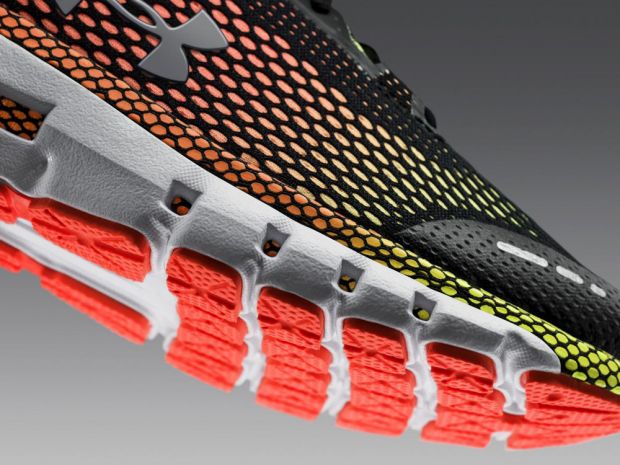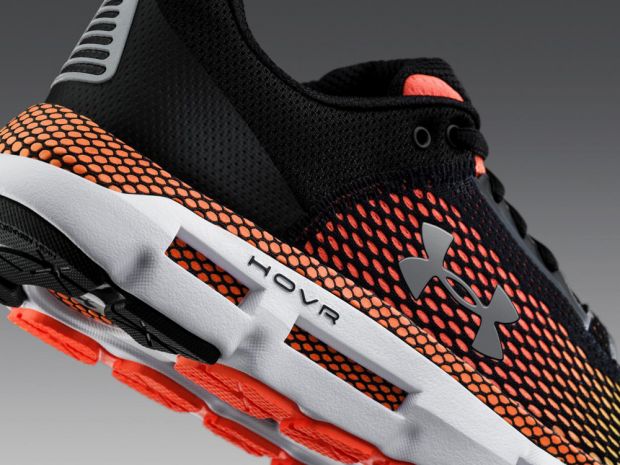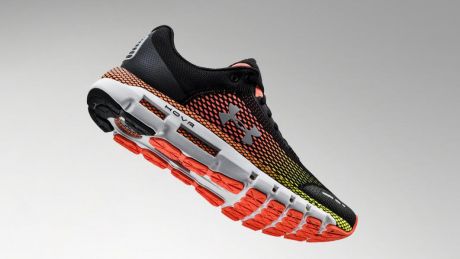You can trust Coach
You’ve got to hand it to Under Armour – it’s certainly come out swinging for the fences with its spring running shoe releases. Five shoes have been launched at once, all of which contain the UA Record in the sole, a sensor that automatically tracks your run.
The Hovr Infinite is the centrepiece of the range, a neutral shoe with a hefty stack of Under Armour’s Hovr cushioning that’s designed for logging a lot of miles in comfort. Other releases include the Velociti 2 for faster runs and the Guardian, a stability option for overpronators.
There are two aspects of the Infinite to review: the smart features and its performance as a running shoe. We’ll start with the former, because new tech is always fun.
First some bad news – the Infinite will only link to Under Armour’s MapMyRun app, which doesn’t sync runs to Strava or other popular run-tracking apps. If you want all your runs in one place that’s annoying, but even if you’re happy to switch apps it’s bad news, because I’ve always found MapMyRun sluggish compared with other apps, not to mention the fact that all your (or at least all my) pals will be on Strava.
Connecting the shoes was a bit of a palaver, with the app failing to find them or, when it did, crashing when it tried to update the software on the sensor. Eventually app and shoe resolved their differences and the connection was made. Since then I’ve had no problem in getting the two to talk to one another.
Once they’re linked you can go for a run without activating anything and the shoe will automatically track it and sync it to MapMyRun when you next open the app.
The sensor will record key stats like your distance and pace along with info on technique like cadence and stride length. There’s only one sensor in a pair, so the stride length records the distance between your right foot’s landings. I say that because when it showed an average stride length of over 250cm I was utterly baffled, because that’s longer than Usain Bolt’s stride length over 100m and I hadn’t been running on the moon. Halve the number for your actual stride length.
What you don’t get if you let the shoes automatically track your runs is a GPS map, because the shoe sensor doesn’t have a GPS chip built-in, so it’s best to hit start on the MapMyRun app if you want the map (who doesn’t want the map?). Once you’re done, the information from the sensor will sync into that session.
After a few runs you’ll start receiving personalised tips in the MapMyRun app, covering how long your stride should be and how you can stay in the target range, which naturally changes with pace. It’s an interesting idea, but since you can’t link the sensor to a watch to show your stride length during a workout its application is limited. Trying to change your stride length based entirely on feel is pretty tricky. It’s also not something I think people should do without seeking expert advice that’s personal to you, because fiddling with your running technique for no good reason could lead to injuries.

One great benefit of having the sensor is that it links to virtual training app Zwift, which is currently free for runners to use. Download the Zwift app to your phone or tablet, link it to the Infinite and your treadmill sessions will instantly become more interesting as you watch your avatar run around a virtual world. A standalone footpod to use with Zwift costs at least £25, so it’s certainly a bonus that the Infinite means you can skip that extra cost.
However, other than that I’m not entirely convinced by the benefits of a connected shoe. Any coaching advice is only available after your run, and the stats measured are not unique – any decent running watch will record cadence and many offer stride length too, and they’ll let you see this info during your run if you are trying to tweak your gait.
Throw in the fact that the Infinite only connects to MapMyRun and it becomes even more niche. If the sensor starts playing nice with other apps and wearable devices, as well as recording more in-depth stats like foot strike or even running power, Under Armour might be onto something. Right now, though, it’s a novelty you’ll probably look at twice then forget about.
Fortunately the shoe has something to offer beyond the tech in its sole. The Infinite is designed as a luxurious-feeling daily trainer to rival the likes of the Saucony Triumph ISO 5 and Brooks Glycerin 16, and at £120 it undercuts them both (£140 and £135 respectively).
See related

The Infinite doesn’t match the plush feel of either of those shoes, though, especially when it comes to the upper, which is breathable and lightweight, but not as padded and comfortable as the Glycerin’s in particular.
The ride of the Infinite is also firmer, especially straight out of the box. I found it broke in a little, but it’s still quite a firm ride for a daily trainer designed for long runs and easy days. It doesn’t have the springy feel you get from an Adidas shoe with Boost foam or the Everun foam used by Saucony. It feels a little lifeless in comparison and it’s not especially smooth moving from heel to toe.
That all sounds bad, but the Infinite is still a decent shoe, especially considering it’s a lot cheaper than other premium options. The ride isn’t outstanding, but you can log a lot of miles in it comfortably, and though it weighs just over 300g it doesn’t ever feel heavy. I wouldn’t pick it for a track day or tempo run, but if you up the pace during an easy run it doesn’t feel cumbersome.
The connected features of the Infinite need work if they’re going to be of real value, but the shoe itself is a solid daily training option, and it’s nice to have the back-up of your shoe tracking your run if your phone and watch both run out of battery. There are better plush everyday trainers out there, with the Saucony Triumph ISO 5 still reigning supreme in my opinion, but the Infinite is a cheaper option that still delivers a comfortable ride.
Buy men’s from Under Armour | Buy women’s from Under Armour | £120

Nick Harris-Fry is a journalist who has been covering health and fitness since 2015. Nick is an avid runner, covering 70-110km a week, which gives him ample opportunity to test a wide range of running shoes and running gear. He is also the chief tester for fitness trackers and running watches, treadmills and exercise bikes, and workout headphones.

